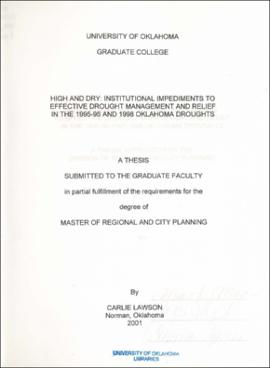| dc.contributor.author | Lawson, Carla Louise | |
| dc.coverage.spatial | United States. | |
| dc.date.accessioned | 2022-08-18T13:51:02Z | |
| dc.date.available | 2022-08-18T13:51:02Z | |
| dc.date.created | 2001 | |
| dc.date.issued | 2001 | |
| dc.identifier.uri | https://hdl.handle.net/11244/336469 | |
| dc.description | Thesis (M.R.C.P.)--University of Oklahoma, 2001. | |
| dc.description | Includes bibliographical references (leaves 162-178). | |
| dc.description.abstract | This thesis examines the abilities of government entities and non-governmental organizations (NGOs) in Oklahoma to work in concert using institutional and organizational learning precepts to effectively plan for and mitigate the effects of drought. Drawing from academic literature in the areas of organizational learning, drought prediction, planning and mitigation and Oklahoma agricultural production, specifically in the areas of wheat and cattle operations, and newspaper articles in the areas of Oklahoma drought prediction, planning and mitigation, Oklahoma agricultural production, heat wave and wildfire it paints a more complete portrait of drought mitigation in Oklahoma. It develops this portrait with interviews of key individuals. Finally, survey results from a University of Oklahoma drought study provide insight into the details of mitigating drought in Oklahoma from the perspective of fire, emergency management and agricultural staffs.
The droughts of 1995-96 and 1998 forced intricate inter-agency planning and mitigation between, for example, the Oklahoma Department of Civil Emergency Management, the Oklahoma Water Resources Board, the Oklahoma Department of Agriculture, and non-governmental organizations such as Feed the Children. The state government failed to experience significant learning on the double loop level, although some individual agencies, did experience single loop learning. One attempt at learning occurred during the year between the two droughts, 1997, when the state of Oklahoma authored a drought plan which this study finds seriously lacking. The plan only suggests responses; does not address responses for consistently recurring problems such as water shortages; does not contain specific, detailed instruction for implementing responses and suggests collaborations between agencies and entities that no longer exist. It provides no one agency with directorial powers. As far as one can determine from a comparison of historical data from both droughts, the plan made little to no difference in actual mitigation. | |
| dc.format.extent | viii, 218 leaves | |
| dc.format.medium | viii, 218 leaves : ill. (some col.), col. maps ; 29 cm. | |
| dc.language.iso | eng | |
| dc.subject.lcsh | Drought relief | |
| dc.subject.lcsh | Drought management--United States | |
| dc.subject.lcsh | Drought forecasting | |
| dc.title | High and dry: institutional impediments to effective drought management and relief in the 1995-96 and 1998 Oklahoma droughts | |
| dc.type | Text | |
| dc.contributor.committeeMember | Coffman, Theresa | |
| dc.contributor.committeeMember | Marshment, Richard | |
| dc.contributor.committeeMember | Meo, Mark | |
| ou.group | Division of Regional and City Planning | |
